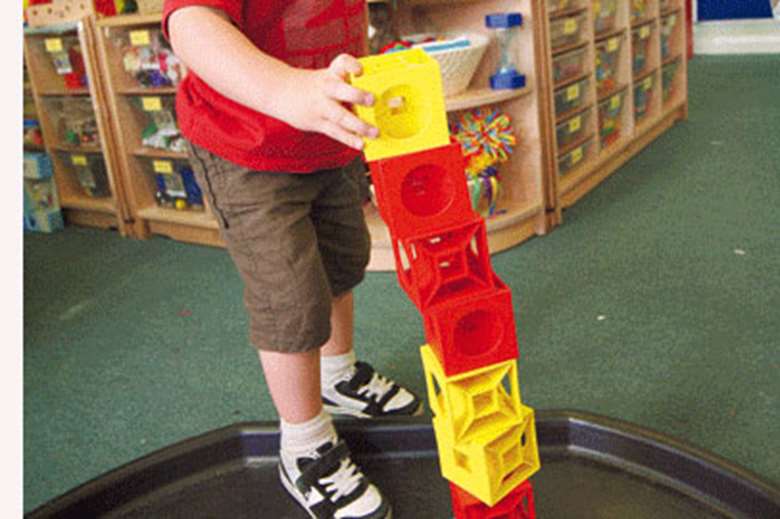Enabling Environments: Around the nursery - Construction Area - Starting blocks
Jane Drake
Wednesday, November 28, 2007
Build up your setting's construction area carefully, with attention to the movement around it and materials with the most potential, says Jane Drake.

The construction area is an important part of any basic provision and, when well resourced, can offer learning opportunities across the curriculum. It will be particularly rich in opportunities for designing and making within the area of 'Knowledge and understanding of the world'.
RESOURCES
Aim to provide:
- Commercially produced kits - select these carefully, according to the skills and concepts that they are likely to promote. Sets may include interlocking bricks, cogs and wheels, nuts and bolts, connectors. Components should be of good quality and durable and should be plentiful enough to avoid frustration
- Wooden blocks - a set of maple wood unit blocks, although a substantial financial investment, will be a valuable addition to provision. Hollow blocks and small-scale planks also offer great play opportunities
- Rulers and tape measures
- Hard hats and play tool boxes (including drill, screwdriver, hammer, spanner and pliers)
- Clipboards, paper and pencils, ring file containing plastic pockets for children's own plans and drawings
- Builders' merchants' catalogues
- Local street maps, aerial photographs of the local area
- Display material to stimulate ideas - for example, architects' plans, photographs of buildings under construction, sequenced photographs of children's own constructions in progress, photographs of new nursery equipment being assembled (such as a storage unit or scooter).
Organisation and location
- The construction area should be as spacious as possible to avoid frustration for children, who need space to build vertical and high constructions and also long, low structures. They should be able to move easily around their work and have enough room to sit, kneel or lie on their tummies as they work. The space should allow for children to work collaboratively on a large group initiative. Alternatively, children may want to work in pairs or individually. As children will be working on the floor, carpeting or a large rug is the most appropriate covering.
- The position of the area is important. A thoroughfare is not a suitable location, as any children or adults walking through the space are likely to disrupt play or damage constructions.
- Positioning the area in close proximity to the small-world provision will enhance and increase play opportunities. Where this is not possible, a selection of small-world resources can be provided in the construction area.
- Open shelf units are ideal for displaying storage baskets and templating equipment, such as unit blocks. Wheeled trolleys containing sliding trays or boxes are also useful for containing sets of equipment. Storage baskets, trays and boxes should be clearly labelled with words and a photograph so that information is accessible to both adults and children.
- Children need to be sure that their work is safe, so an area designated for finished models, or work in progress, should be available. All children should understand that they can look at a displayed model but that they should not touch it without permission from the child who made it. It is a good idea to provide folded card labels and pencils and encourage children to name their displayed work before leaving the area. This display can also provide a focal point for children to talk about their ideas and plans with parents and carers.
- Practitioners may agree rules with children about dismantling work - perhaps, all displayed models are dismantled on a Friday so that the shelf is clear, and stocks of bricks and components in storage baskets are replenished for the next week.
Outdoor provision
Children enjoy working on large-scale projects and such experiences outside enable them to explore ideas that may not be possible or practical inside. Lifting and manoeuvring larger equipment also offers children opportunities for physical development. Resources could include large wooden blocks and planks, crates, tyres, log slices, cardboard tubes, cardboard packaging and boxes. There may be safety issues related to transporting, and building with, large equipment, so supporting adults will need to address these appropriately with children.
Experiences
- Exploring and handling equipment
- Building towers
- Tessellating and lining up blocks
- Finding out how components work together
- Constructing houses, castles, roadways, model vehicles, people and animals
- Developing stories around built environments or models
- Pretending to be construction workers
- Making props to support play in other areas (for example, making a bed for a doll in the home corner)
- Dismantling models
Learning
- Exploring solid and flat shapes
- Showing an interest in how things work or how they are made
- Identifying features of components and other pieces of equipment, sorting and matching
- Building with a purpose in mind
- Experimenting with different equipment for the same purpose
- Selecting appropriate equipment and techniques for a task
- Counting and calculating items used
- Using mathematical language, such as 'long', 'short', 'longer', 'shorter', 'big', 'small'
- Developing ideas over time
- Using imagination and representing first-hand experiences in play
- Showing control and co-ordination when manipulating equipment
- Understanding safety issues related to building and developing strategies to minimise risk - for example, making a solid base for tall constructions
- Solving practical problems and responding to a challenge - for example, 'Can you build a bridge tall enough for the bus to go underneath?'
- Following simple picture instructions and diagrams
- Taking about own constructions and recording ideas on paper
- Giving and following verbal instructions
- Becoming deeply involved in own play and learning
- Working co-operatively and collaboratively with others
LINKS TO EYFS GUIDANCE
- UC 1.1 Child Development (a competent learner)
- PR 2.3 Supporting Learning
- EE 3.3 The Learning Environment
- L&D 4.2 Active Learning
- L&D 4.3 Creativity and Critical Thinking
- L&D 4.4 Areas of Learning and Development (all areas).




